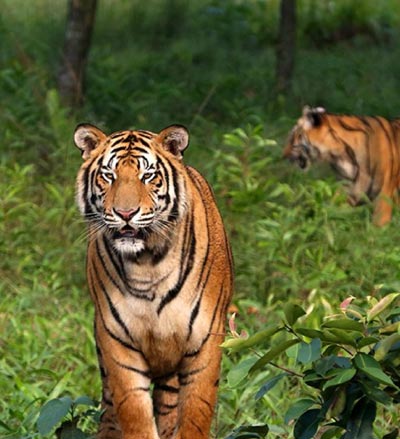
Sariska Tiger Reserve
Sariska Tiger Reserve is a national park where you will find a perfect intermingling of nature. It contains mountains, grasslands, dry deciduous forests and cliffs which span over 800 square kilometres. Situated in Alwar, the Tiger Reserve is nestled in the lap of Aravali hills. Currently home to numerous animals apart from tigers, the reserve showcases nature in its best form. Animals like jungle cats, rhesus macaque, sambhar, chital, wild boar, etc., are found here. Not only animals, you get to see a number of bird species, such as sand grouse, harbor quails, crested serpent eagles, etc. here as well. If you are planning a visit, here’s what you can do when you are here
Historical Importance of Sariska
Sariska in Alwar district beholds the legacy of the Maharajas of Alwar since the ruins of pavilion and temples of the then ages within the Sariska zone bring the glory and richness of Rajputana period. The 17th century old Kankawadi Fort, at the center of the reserve has a long and tumultuous history. This fort was being built by Jai Singh II. The fort is being known for the imprisonment of Dara Shikoh by his brother the Mughal Emperor Aurangzeb for the succession of the throne.
The presence of prominent temples actually brings great traffic creating some problems to the wildlife although, but still they are really significant. The center of Sariska is also being famed for Pandupol, one of the retreats of Pandavas and the famous Hanuman temple is the reason for the favorite pilgrimage site. Significantly, the Nilkanth temple built by the Barjgujars and the Bhartihari temple is also being crowded with many pilgrims frequently. The Neelkanth or Rajor Gath was the capital of Bargujars and Raja Bhartihari, the ruler of Ujjain mediated at the Bhartihari temple.
Apart from that Sariska is also renowned for Tal Briksh, the hot water spring and many royal buildings including the Sariska Palace, which was used as the royal hunting lodge of Maharaja jay Singh.
Wildlife in Sariska Reserve
Today, the park is home to numerous carnivores including Leopard, Wild Dog, Jungle Cat, Civets Hyena, Jackal, and Tiger. Their common preys are species like Sambar, Chital, Nilgai, Chausingha, Wild Boar and Langur. Sariska is also well known for its large population of Rhesus Monkeys, which are discovered around Talvriksh.
Most importantly, Sariska also represents great amount of the Avian world including Peafowl, Grey Partridge, Bush Quail, Sand Grouse, Tree Pie, Golden backed Woodpecker, crested Serpent Eagle and The Great Indian horned Owl.
Flora in Sariska
Although the area of Alwar is being recognized as a dry deciduous region but with the onset of monsoons the whole ambience becomes so impressive to attract the visitors for appreciating the natural beauty. Basically, the forest type is tropical, dry, deciduous, and tropical thorn and is regarded as the sole forest patch in the whole world of the western Aravali Hills. No doubt, greenery can rarely being traced at this region because of its localizing in India's deserted land-Rajasthan. However, Sariska plays a major role for the only mushy area of the Aravali ranges. The topography of this sanctuary is comprised of small hills and narrow valleys with dense busy shrubs amidst the rocky terrains. Such a landscape that witnesses less rainfall (avg. 650 mm/year) generally leads to the growth of dense vegetation to comprise scrubby trees and bushes. All in all the Sariska reserve is basically a group of arid yet dense shrubby forest.
Places of Interest
Kanakwari Fort - One of the best illustrations of a jungle fort in India, the Kanakwari Fort lies within the Sariska reserve area within the ranges of 18 kms from the entrance gate. The spot is obviously hard to find as it lies deep inside the tiger infested forest. This was the place where Prince Dara Shikoh, heir to the Mughal throne, was held captive by his brother Aurangzeb. A steep rise of stairs will lead to the fort to bring the faded ancient wall paintings that still reflect the Rajputana eloquences.
Sariska Palace - The Sariska Palace inside the reserve area was once the hunting lodge for Maharaja Jai Singh of Jaipur. This is the most visited place for the number of tourists, even if they are not dwelling for the tiger tours in Sariska. The palace is decked with sprawling lawns, antique furniture and interesting photographs of the Royal Shikar of the 1920s and is now converted into a museum.
Naldeshwar Temple - The Naldeshwar Temple is being located at some distance away from the reserve area at the Alwar-Jaipur highway joining Sariska to Alwar. This temple is easily accessible by foot once reaching at the highway. The temple is dedicated to Lord Shiva and is surrounded by dense greenery to bring a pristine environment for much overwhelming moments. This 18th century old temple showcases some different ambience around the deserted land of Rajasthan.
Neelkanth Temple - The temple of Neelkanth, dedicated to Lord Shiva is encircled by the Aravali ranges and is quite closer to the Sariska reserve. This ancient temple also looks like a rocky museum which is studded with sculptures, carvings and scriptures similar to the ones excavated at Khajuraho and so also has some historical importance too.
Bharthrihari Temple - Located at 30 kms away from the Sariska reserve, this temple is dedicated to an ancient sage Bhartrihari to attract many Hindu devotees. This temple stands above the samadhi of Yogi Bhartrihari Nath and is known for its excellent Rajasthani style of architecture.









